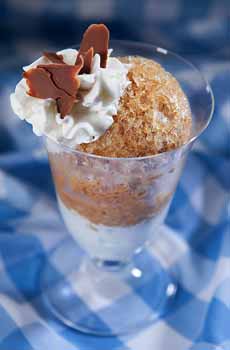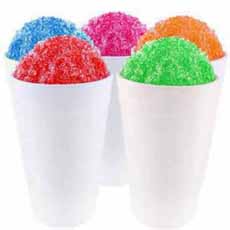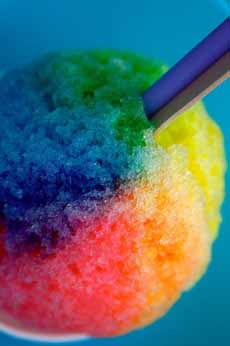Grown Up Snow Cones
|
Remember your childhood summers, and how happy a snow cone made you? The rainbow snow cone (photo #3) was our personal favorite.
Alas, when one’s palate evolves, those overly-sweet syrups from street vendors no longer bring pleasure. And the day-glow colors? Sheesh! One way we’ve worked around this is to make adult snow cones with a better syrup like Monin or Torani—still pretty sweet—combined with a matching liqueur, in a 1:1 proportion. If you have an ice crushing machine or a snow cone machine, it’s a great idea for a casual summer cocktail party. And then, there’s the iced coffee snow cone, a riff on one of America‘s favorite warm-weather beverages. We adapted this recipe from one by Nuggets Market—12 locations in northern California. You can have a family-friendly iced espresso, or add Kahlúa or your favorite coffee liqueur. Instead of coffee, you can make a variation with chai concentrate (we use Original Oregon Chai Tea Latte Concentrate), or with strong-brewed tea. Serve them in a vessel of choice. Since we never got around to buying paper cones, we use a rocks glass and a spoon. Ingredients For 2 Servings 1. COMBINE the 2 espresso, vanilla extract, Coffee Mate and optional liqueur, and let chill in the fridge for 10 minutes. Once the mixture is chilled… 2. SHAVE the ice. Fill a blender halfway with ice cubes and use the “crush” setting. Don’t fill the blender more than halfway or the top ice won’t get crushed. 3. FILL the serving cups one-third full with whipped cream. Add the ice, pour the espresso mixture over ice, top with whipped cream and chocolate shavings. Snow cones are the oldest form of ice cream—if you substitute a bowl or cup for the a cylindrical cone, which came much later (the history of ice cream). The original “ice cream,” made in China some 4,000 years ago, consisted of flavoring snow with syrup. Fast forward to the 1850s, and you have ice shaved from large blocks into a paper cone or cup, topped with syrup. Shaved Ice In 11th Century Japan In 11th-century Japan, kakigori, a shaved ice dessert, is believed to have already existed. It was made from ice harvested in winter and stored in ice houses: a luxury available only to the wealthy nobility. Ice was shaved into a metal bowl and eaten with a sweet sap from vines, hydrangeas, and ivy, with some golden syrup on top. Around the 19th century, with the ice-making technology of the Industrial Revolution, kakigori was finally affordable to the general public. The first kakigori shop was opened in 1872. The ice was flavored with fruit syrup, and optionally topped with adjuki beans and sweetened condensed milk. Kakigori became a common treat, leading to modern versions of Japanese shaved ice and Hawaiian shave ice [source]. On the other side of the world, in the U.S., historians trace the snow cone to Baltimore in the 1850s. When blocks of ice first began to be manufactured commercially, ice wagons would transport the huge blocks from factories to businesses—not just locally, but interstate. |
 [1] An espresso snow cone, a fun alternative to iced coffee (photo © Nuggets Market).
|
|
|
On hot days in Baltimore, on the route from New York to Florida, children would run up to the ice wagons and ask for small scrapings of ice. Mothers began to top them with syrups, and called them snowballs. One of the easiest toppings to make at home was egg custard, a simple mix of eggs, vanilla and sugar (hold the cream!). It gave the “snow” a creaminess, closer to ice cream than the bright-colored fruit flavors that subsequently became popular. Sources name Baltimore as the home of the “egg custard snowball,” where it remains a prevalent summer snack (photo #4—it’s now often topped with melted marshmallows). By the 1870s, Baltimore theaters would sell snowballs in warm months. According to Wikipedia, “Signs in theaters instructing patrons to finish their snowballs before coming in to the second act are the earliest tangible evidence of snowballs.” Around the city, snowballs were served on newspaper, but in the classy theaters, butchers’ boats were used. In the 1890s, patents for electric ice shavers were filed as Baltimoreans sought faster alternatives to hand-shaved ice. Snow Cones In Texas As the recipe spread, the name evolved. Plop the shaved ice into a paper cone or cup and call it a snow cone. In 1919, Samuel Bert, who would invent an ice-crushing machine the following year, sold snow cones at the State Fair of Texas. But ice continued to be largely hand-shaved until Ernest Hansen of New Orleans patented the first block-ice shaving machine in 1934. According to Wikipedia, during the Great Depression, snowballs became more readily available around the U.S. A cheap treat, they were nicknamed Hard Times Sundae and Penny Sunday. Hansen’s ice shaver produced ice that had the consistency of snow, unlike the other ice shavers, which produced rough, crunchy ice (think granita)—a true snow cone [source]. With milk rationing during World War II, snow cones became a go-to icy treat. Today’s snow cone syrups, available in dozens of flavors, have one thing in common: They’re all made in vibrant—not necessarily natural—colors.
|
||





